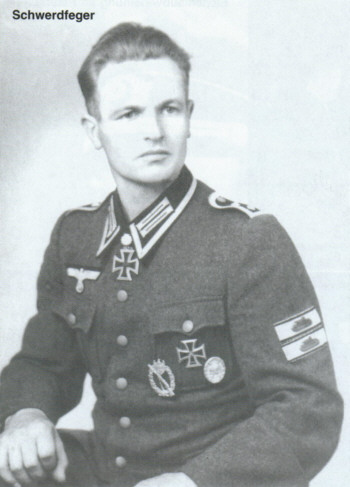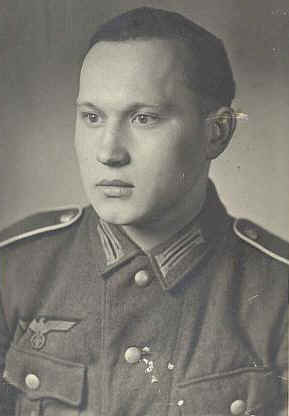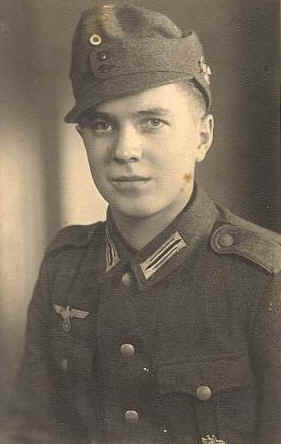The
Cross of Iron by Willi Heinrich |
I was pleased to find some
information on The Cross of Iron on the internet, posted by Hardy Huber to the message
board at www.feldgrau.com
He has graciously given permission for this information to be reproduced here, as
well as new information regarding his uncle.
THE CROSS OF IRON
by Willi Heinrich The
Cross of Iron is a very well known book, originally by Bobbs-Merrill in 1956 and
republished many times since then. In 1977, in a rare international co-operative effort,
the book was made into a major motion picture, released in both Germany and the United
States, starring James Coburn, Maximillian Schell and James Mason.
There has been speculation over the years as
to how much of the story is true, or if the characters in the book and film represent real
people. The author's biography of the 12th printing states that the author, Willi
Heinrich, "...came by his competence (as a writer) honestly and bitterly as an
infantry officer in a fearfully mauled German division that bit deep into Russia and
withdrew its remnants in broken retreat." |
Hardy Huber, the nephew of a soldier who fought and gave his life on the Russian
Front, shares with us the following:A
while ago I read some questions ... about the unit Heinrich is referring to, in his book
"The Cross of Iron.” One of my relatives served in the 229. Jäger
Regiment of the 101.Jäger Division and by researching his service I came across Willi
Heinrich. Heinrich was born in 1920 in Heidelberg and served during the war in the
First Battalion, 228th Jäger Regiment (I./228.Jg.Rgt.), part of 101 Jäger Division.
He was wounded five times. Willi Heinrich is still alive and lives in Karlsruhe.
There are several clues in the book that will
identify the 228 Jäger Regiment of the 101.Jg. Division as Steiner's unit.
- Page 13, second paragraph; He (Steiner) had
been wounded at Izyum and hospitalized at home.
The 101 Jäger Division was fighting in this sector in May and June 1942.
- Chapter II; "The Regiment’s new
positions ran west of Krymskaya through hilly terrain bare of vegetation. The dominant
feature of this sector was Hill 121.4... " Compare this to an entry in the
regimental history of the 228 Jäger Regiment on May 26th 1943: “Kampfgruppe
Busche (101.Jg.Div.) wird zum Gegenstoß auf die verlorene Höhe 121.4 angesetzt”.
(Battle Group Busche from 101 Jäger Division will take the lost hill 121.4 back.)
Source: Kriegstagebuch des Jäger Regiments 228
- Lieutenant Colonel Karl Busche was the
commander of the 228 Jäger Regiment. He was awarded the Knights Cross on 28.02.43 and was
killed in action on the 28th May 1943 trying to take back hill 121.4
The battle of hill 121.4 is described in "The Cross of Iron”
- Page 33; Meyer tells Stransky that Steiner
saved Lieutenant Colonel Brandt's life, “He was still company commander when the
regiment was stationed in Pribram. They got into a bad spot – that was in the
beginning of the Russian campaign – and Steiner saved his life.” In the
original German edition on page 41 is an account of the incident, this account is omitted
in the English translation. Meyer (his name is Schäfer in the German edition) tells
Gausser that Steiner saved Brandt’s (Strauss in the German book) life a year ago at
Studenok on the Donez (not at the beginning of the Russian campaign, the German text says
that Brandt and Steiner know each other since the beginning of the Russian campaign.) "Steiner
hat ihm einmal sein Leben gerettet." and “Es war bei Studenok am
Donez. Strauss führte damals schon das Bataillon. Die zweite Kompanie lag, soviel mir
bekannt ist direct am Donez. Den Russen war es gelungen, bei Nacht über den Fluss zu
kommen. Bei den Kämpfen wurde die zweite Kompanie fast völlig aufgerieben…"
( “Steiner saved his life once…. It happened at Studenok on the Donez. Brandt
led the battalion at that time already. The second company was situated, as far as I know
directly at the Donez. The Russians had succeeded in crossing the river at night. In the
battle the second company was almost completely rubbed out.) This actually took
place on the 19th and 20th of May 1942 see: Hans
Kissel: Angriff einer Infanteriedivision (Die 101. le.I.D. in der Frühjahrsschlacht bei
Charkow. Mai 1942). 1958; and also Kriegstagebuch des Jäger Regiments 228; According to these Sources, a company of the
I./228.Jg.R. was surprised and pinned down by Russian forces (two Regiments and eleven
tanks of the Russian 296. Division) that crossed the Donez in the night from the 19th to
20th of May 1942. It took the 101.le.Div until the 23th of May to clear the western bank
of the Donez of the enemy.
- There was also an Oberfeldwebel in the
228.Jg.Rgt. that was awarded the Knights Cross on May 17th 1943, his name is Johann
Schwerdfeger, platoon leader 1./JägRgt 228. Could he be the inspiration for the character
of Steiner?
|
| From this website: The
Real "Sergeant Steiner"?
Johann Schwerdfeger was born on 24 November 1914, in Plein
bei Wittlich. He served from 1935 to 1937 with Infanterie Regiment 84, and at the
beginning of the campaign in Poland transferred to the Third Company of Infanterie
Regiment 186 (73rd Infantry Division).
In June 1942, after service with Jägerersatzbattaillon 75,
Schwerdfeger joined Jäger Regiment 228, part of the 101st Jäger Division. The
division saw action in the Don Bend, at Rostov and Maikop in the Caucasus, and joined the
retreat through the Kuban and the Taman Peninsula.
On 17 May 1943, Feldwebel Schwerdfeger was awarded the
Knight's Cross as a platoon leader in the First Company. In April 1944, during the
breakout from Hube's Pocket, he was severely wounded and on 14 May 1944 was awarded the
Oak Leaves to the Knight's Cross.
Image by kind permission of Robert
Balsam
Ritterkreuzträger der
Wehrmacht
http://www.ritterkreuztraeger-1939-45.de |
 |
|
My Uncle, after only six weeks on the eastern front was
killed in a small village 3km east of Izyum on June 22nd 1942. He was nineteen years old.
I tried over the last thirty years to find out more about his fate.
Jäger Willi Maier
Jägerregiment 229, 101. le. Division (Jägerdivision)
Born: 29 August 1922, Langensteinbach, Karlsruhe
Died: 22 June 1942
Location of Death: Rossochowatij bei Isium.
According to the official letter my Grandmother received, he was with a small
reconnaissance group of the 7.Komp., Jägerregiment 229, 101.le.ID. Upon entering
the small village of Rossochowatij near Isium (Ukraine) the group was met by retreating
Russians incl. a T34 tank and annihilated. A comrade and school mate of my uncle who
was not part of the recce group that day, told my Grandmother later, that the
reconnaissance group, let by a young Leutnant, was to find out if there was enemy activity
in Rossochowatij, but they were under orders not to enter the village. The Leutnant,
against orders and the advice of the accompanying Unteroffizier, decided to capture two
light trucks and their crews, that he believed were the only enemies in and around the
little village. Only a few of the group got out alive, amongst them the Leutnant who was
subsequently degraded to an NCO rank. The comrade told the story to my Grandmother when he
was on home leave in the fall of 1942.
His Name:
Gefreiter Ludwig Augenstein
Feldpostnummer: 27453 C,
7 Kompanie, Jäger Regiment 229
Born:4 August 1922 in Langensteinbach, Karlsruhe
Went Missing in Action: 26 May 1943, Krymskaya
This was the day that Hill 121.4 was stormed by the 101st Division.
 |
 |
Jäger Willi
Maier
Recruited to Infantry Regiment 109 (35th Division) Sep 1941 (Karlsruhe)
Transferred to 101 Leichte Division in Ulm for advanced training.
Early May 1942 sent to Slaviansk.
Killed in Action 22 June 1942 |
Gefreiter
Ludwig Augenstein
His Jäger cap badge and Infantry Assault Badge are just visible in this
photo. |
Special thanks to Hardy Huber
for making this page possible.
Hardy also has a page devoted to his father, Oberjäger Gerhard Huber: http://www.eagle19.freeserve.co.uk/huber.htm


